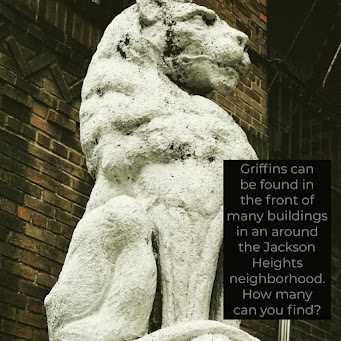
New York City neighborhoods are rich in history, and Jackson Heights is no exception. Situated in a rectangular swath of Queens, with Northern Boulevard, the expressway, Roosevelt Avenue, and Junction Boulevard as its perimeter borders, this neighborhood boasts a charming collection of beautiful pre-war residential buildings, many of which feature intriguing architectural adornments, including the presence of mythological creatures like Griffins.
Griffins, fascinating creatures that are half-lion and half-eagle amalgams, grace the façades of numerous buildings in Jackson Heights. These majestic beings typically possess bird-of-prey talons for feet and lion-like tails. Although occasionally depicted without wings, or even as wingless eagle-headed lions, these figures bear a striking resemblance to Griffins. Interestingly, even the neighborhood's local school, Garden School, an independent nursery through twelfth grade, has adopted the Griffin as its mascot.
 |
| While some of the statues in Jackson Heights may resemble guarding lions more than take-flight griffins, there is undoubtedly a family resemblance. However, I must confess that I am not a pedant when it comes to classifying mythological creatures, and their presence in the neighborhood adds to their unique character and charm. |
The abundance of griffins in Jackson Heights has a historical significance that traces back to the neighborhood's early days. When the Inter-Borough Rapid Transit company constructed the 7 elevated line that runs over Roosevelt Avenue, Jackson Heights and much of Queens were mostly undeveloped farmland, with only a few notable features such as the waterfront natural harbors in Flushing and Long Island City. However, the arrival of the elevated subway sparked a wave of housing development. The Queensborough corporation, whose remnants can still be seen, particularly at the corner of 79th Street and 37th Avenue, decided to build "garden apartments," forever altering the area's landscape. The apartment buildings were billed as convenient upper-middle class residences for the white, non-Jewish, non-Catholic, white-collar set. One brochure for one of the apartment buildings, The Towers, reads, "The people you find at Jackson Heights are only those people you want to associate with." Anyway, after the Second World War — with the advent of white flight in the 1960s and 1970s, the demographics of the neighborhood shifted — but the garden apartments remain — in their unsullied glory. And the griffins. Talons out!
If you take a stroll through Jackson Heights, you can spot various griffins and griffin-like statues in specific locations. Here are some approximate locations where you can find these captivating figures:
- 72nd Street and 35th Avenue - Griffin
- 75th Street and 35th Avenue - Griffin
- 81st Street and 37th Avenue - Griffin
- 81st Street between Northern Boulevard and 34th Avenue
- 34-48 81st Street (between 35th and 34th Avenues) - Stone carving of two Griffins above the doorway
- 80th Street between 37th and 35th Avenue
If you happen to discover any additional griffins or statues not listed here, please let me know in the comments. Jackson Heights continues to be a treasure trove of fascinating historical and architectural delights, and the presence of these mythical creatures only adds to its allure.
Works Cited
Antos, Jason D., and Theodosiou, Constantine E. Jackson Heights. United States,
Arcadia Publishing, 2013.








